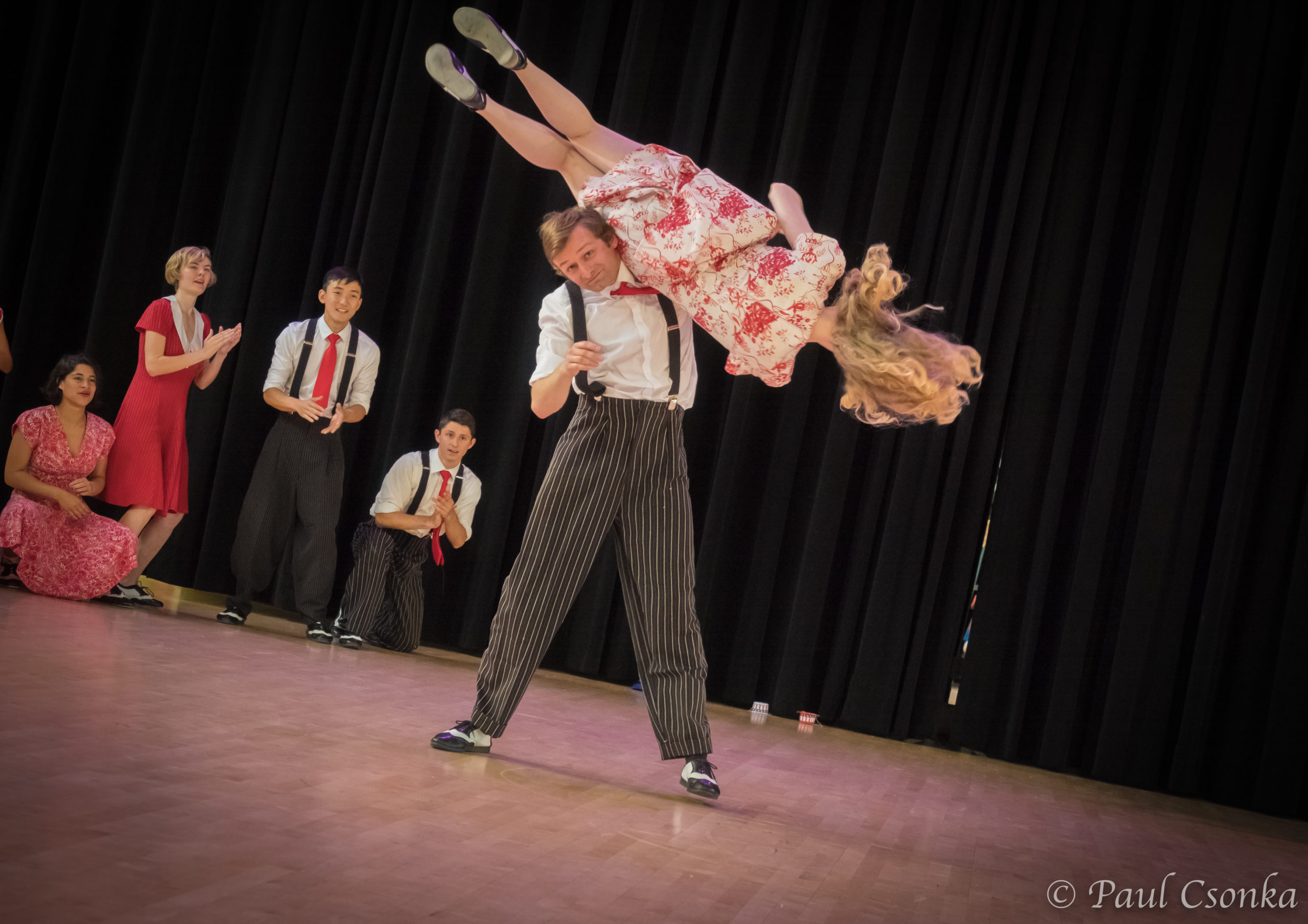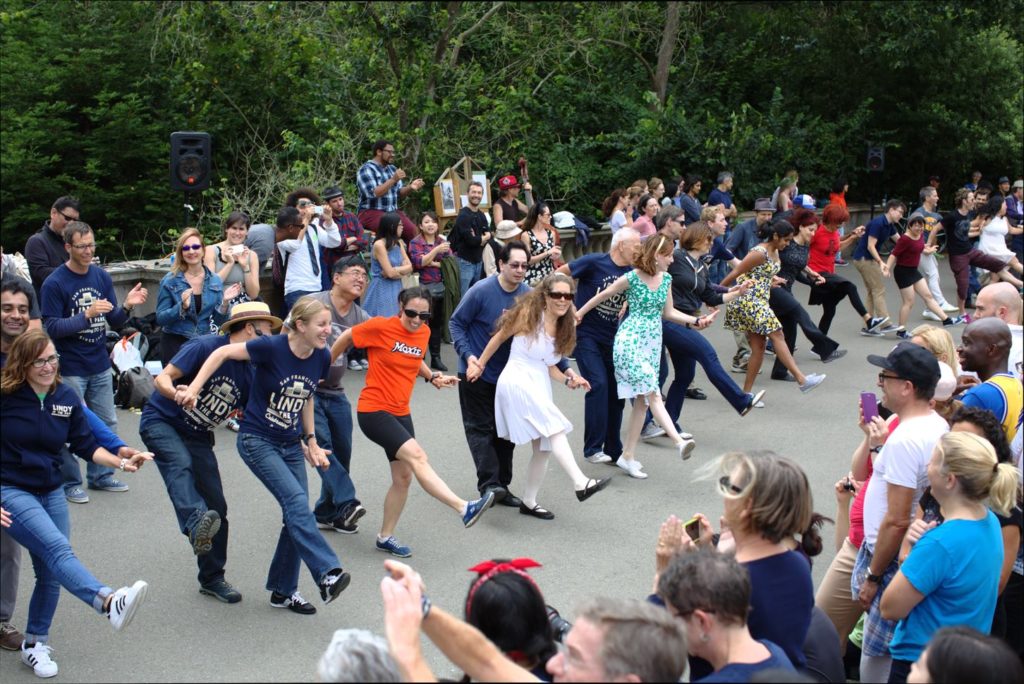
Impossible to resist. You know that toe-tapping, pre- World War II tune “Sing, Sing, Sing” that commands you to dance the moment you hear it? That was the point of the catchy jazz arrangement by Louis Prima, famously performed by Benny Goodman and his orchestra – to get listeners up on their feet. Swing music worked its magic back then – as it does today, conjuring up an intoxicating social dance experience. Jazz music of this kind, treasured by countless people over multiple generations, will never be forgotten. Enthusiasts wouldn’t allow it. For this reason, swing music and dance live on – as it must – in the San Francisco Bay Area and around the globe.
Today, you could say swing has a somewhat underground existence. You’re less likely to see swing events publicized widely through paid advertising outlets. Underground as it may seem, swing communities are far reaching in both rural and urban areas worldwide. Enthusiasts are savvy to knowing precisely where to find the latest happenings in their area; usually online through social media, specific websites, and word of mouth.
Just as important as it is to learn the steps to the various swing dance styles, knowing the basic history of swing and learning about what led to swing’s revival in the 1980s and 90s, is equally essential information for any newcomer to the scene.
Swing emerged in Harlem, New York during the depression and made its mark at the Savoy Ballroom – America’s first swing club showcasing American jazz dance, now known as swing. The first official swing dance, the Lindy Hop, a partner dance driven by African rhythms with dance influences from the Charleston and tap, became an international sensation when legendary Savoy dancer Frankie Manning added aerial dance moves to the Lindy, inspiring a multitude of other swing styles, i.e. the Balboa, Shag, and others – all the way through the end of World War II.
The swing resurgence of the 1980s and ’90s was a pop culture phenomenon. Following the popularity of the 1980 movie, The Blues Brothers, featuring the big band sound of Cab Calloway, and the colossal response to rockabilly music by The Stray Cats, dancers from Sweden and Pasadena, California went on a mission to track down some of the original 1930s/40s swing dancers. Frankie Manning and other notable dancers such as Al Minns agreed to teach an eager generation of dancers the Lindy Hop and other swing dance styles. Classes and workshops led by the legendary dancers were held worldwide, expanding the new generation of swing dancers globally, and prompting the first ever Swing Dance Camp – held in Herräng, Sweden – becoming one of the foremost swing dance events on the global radar to date.
Music influences during the ’80s and ’90s swing revival included the Royal Crown Revue, the Squirrel Nut Zippers, the Brian Setzer Orchestra, and the Cherry Poppin’ Daddies. Movies such as A League of Their Own and Swingers also played a significant role during the swing comeback; as did the 1998 Gap commercial Khakis Swing – featuring Lindy Hop dance to Louis Prima’s “Jump, Jive an’ Wail.”
Often, when we think of swing dancing, high energy lifts and swift aerial dance steps come to mind. Finding this kind of spectator entertainment is fairly uncommon these days; but Stanford Swingtime in Palo Alto – Stanford University’s premiere performance-based swing dance troupe, comprised of Stanford undergraduates and graduate students, has created such an outlet.
Founded in 2002 – the troupe, funded by Stanford University, holds regular auditions – open to Stanford students only with no prior dance experience. While the qualifications are lenient, a hint of verve does go a long way; “Swingtime members are chosen for attitude as much as aptitude,” as it states on the Swingtime audition web page.
Maya Lee Ziv, Digital Media & Alumni Relations Chair for Stanford Swingtime shares, “Some dancers have turned professional. A few Swingtime alums have gone on to compete at Camp Hollywood and other swing events. Paul Csonka, who was Swingtime’s Artistic Director for a few years, is out there making us proud with Audrey Ho, who ran the Stanford Lindy Project for a while.”
Members of Swingtime also host quarterly Stanford Swing Dancers (SSD) events (formerly the Stanford Lindy Project), which are free and open to the public. Current president of Stanford Swingtime, Alexandra Bernard, teaches many of the SSD workshops held weekly at White Plaza on the Stanford campus.
If you’re attending one of Stanford’s quarterly social dance events, such as the annual Big Dance held in the Spring or the Fall Ball, live swing music is a typical standard. Among the favorite featured bands is the Don Neely Swingtet.
SSD events also encourage the following Partner Dance Roles: (1) Don’t assume someone leads or follows based on gender presentation. You can invite someone to dance by asking “Would you like to lead me/follow me in this song?” If you plan to switch roles within a single dance, clear it with your partner first. (2) Wear ribbons (when available) to indicate a willingness to lead or follow or both that night; it will make finding a partner more efficient.

If there’s one swing event in the Bay Area that’s a definite must, particularly for the absolute beginner, it’s San Francisco’s world-famous Lindy in the Park. Every Sunday from 11am – 2pm in Golden Gate Park (weather permitting), 100-200 seasoned and aspiring Lindy hoppers head to San Francisco’s best known, free, outdoor swing hub. From weekly regulars to first time goers, an ethnically diverse crowd of individuals predominantly attend, ranging in age from young adult to seniors in their 80s.
Head instructor Hep Jen and head organizer, co-founder/swing dance instructor Ken Watanabe spearheaded the event back in August 1996, offering a free beginner lesson to help grow the recurring event.
Following college, Watanabe began swing lessons through a Park & Recreation class in Palo Alto and received further training in West Coast Swing, Jitterbug, and Lindy Hop in San Francisco.
Looking back 23 years, during Lindy in the Park’s early beginning, Watanabe says, “At that time, there were only around 30 people actively dancing Lindy Hop and we were all connected via email. One of us knew about the bandshell in Golden Gate Park and thought it would be fun to dance there. For several months, we would talk about it, but never get around to it. Eventually, my friend, Chad Kubo, and I decided to organize an outing to the bandshell, so I emailed everyone on the list. I showed up early to sweep the bandshell, and Chad brought his boombox. To our amazement, the electrical outlets at the bandshell worked! Thirteen people showed up, and we had so much fun that we had 3 more that Summer and Fall. In the Spring of 1997, we decided to make it a regularly weekly event. At the same time, swing dancing became cool again, and as the fad grew, more people were getting into the swing dancing and vintage fashion, more retro swing bands were forming, and more clubs were featuring swing bands and classes. It was kind of like the perfect storm. Word spread and Lindy in the Park grew quickly in size, and the rest is history.”
If night-time swing dance socials with live music and martinis are your thing, there’s some swank venues around town worth checking out.
By night, Watanabe is a swing event producer for the weekly Woodchopper’s Ball in San Francisco, offering live music and dancing every Tuesday night at the historic Verdi Club – a newly renovated 2,500 square-foot ballroom and lounge with a full bar.
What makes attending swing events at the Verdi Club so special? Watanabe explains, “It features the largest variety of live swing dance music in San Francisco. We have a different band each week. So far, we’ve had over 40 bands.”
Regular bands include Clint Baker, Johnny Bones and The Palace of Jazz, the Hot Baked Goods, the Oaktown Strutters, the Cottontails, the Alpha Rhythm Kings, Jellyroll, the Silver Bell Jazz Band, Lisa Gonick & the Damfino Players, the Fil Lorenz Orchestra, Laura Lackey’s Rhythm Revue, Sam Rocha and his Cool Friends, the B-Stars, Rob Reich Swings Left, and Nirav Sanghani and the Pacific Six.
There’s no denying that the Bay Area swing scene has no short supply of live music. That’s one sure way to pick a choice venue for learning swing and becoming a regular; follow the live music. Whether you’re partial to live music or learning how to Lindy in the Park, there’s an abundance of events happening daily in these parts. Get on board now and watch the scene as it grows. Before long, someone will produce another hit film, song, or album that will send people into another burning frenzy, initiating an insatiable desire to learn how to Boogie Woogie. Wait and see.
Sources to find swing scenes:
Cats Corner
For Dancers Only
LindyCircle.com
Lindy in the Park
Northern California Lindy Society
Stanford Swingtime
The Bootleggers Ball
The Breakaway
The Dancers Den
The 9:20 Special
Wednesday Night Hop
This article appeared in the July/August 2019 issue of In Dance.


